Shaping a banjo neck with the usage of hand tools such as rasp, files,
surform tools, sanding drums, sanding belts, etc. allows the craftsman quite
a bit of latitude and flexibility to get the radius portion of the neck as
he or she desires. There are a variety of neck shapes to suit
the individual banjo player with some shaped like a D, Egg or elliptical
shape, v shape and a 1/2 radius shape as done with a shaper or carving
machine.
The production environment and the quantity of necks required dictates
the type of tooling and machinery used and more and more are going toward
the CNC router machines but they are typically slower in production than a
double spindle shaper or multiple ganged carving stations. Either one
requires some hand work around the heel and hand volute area to remove
additional material.
The shaping of the radius portion of this neck will be about as basic as
you can get with hand tools once the bulk is removed at the heel with the
band saw. Back in the 1970s before I had tooling for a double spindle
shaper, the radius portion of the neck was rough cut using a special 2 inch
diameter by 2 inch length cutter mounted on a horizontal spindle at about
1725 rpm or it could have been 3450 rpm, don't remember. That
particular cutter was used in the textile equipment manufacturing business
in Southern Pines, NC to produce wooden shuttles out of dogwood and the
teeth on the cutter were ground at a specific angle to prevent tear out and
"snatching" the item from your hand. You could place end
grain wood directly against the rotating spindle and it would cut without
grabbing it from you. That was a dangerous operation but as long as
you kept your hands away from the rotating cutter, all was well. I
doubt today with all the safety regulations in place, one would be allowed
the usage of such a dangerous cutter in a "freehand style" of
operation without an overkill of protective guards, etc. I know it worked and never had a problem with it and can't
remember who ended up with the cutter and horizontal motor/shaft.
Most of my 1970s rasps, files and surform tools are about worn out and
should be able to get this one shaped which will take additional time but I
am not on a delivery schedule. One needs a simple fixture or jig to
hold and position the neck during the shaping process and I found a piece of
Honduras Mahogany that was used on my aluminum bass boat to support the
plywood flooring. That piece of wood has been in my possession for at
least 35 years and will work fine although I hate to cut up a piece of wood
of that type for a simple fixture but I have no other need for it and
have nothing in 8/4 thickness and this piece of Honduras Mahogany has several test holes drilled into it
rendering it useless for a banjo neck blank.
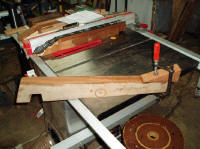
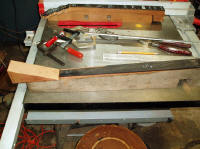
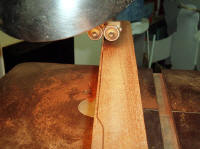

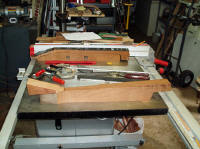
Above pixs show the progress of the neck holding fixture. The notch
cut out in the piece of mahogany was used to straddle the center member of the bass
boat frame and will work perfect for this fixture with a little
modification. I added a piece of material to one end where the peghead
will be clamped in place and the angle is about right for this neck blank.
The wedge could have been made adjustable for other neck peghead angles but a simple padded caul
underneath the peghead will work just as well and offer protection to the
peghead to prevent marring or denting from clamp pressure. I pinned and glued the angle/wedge in place and
allowed to dry overnight and then traced the profile of a 5-string
fingerboard (fret side down) and band sawed to the line. The fixture will be clamped
into a vise and the neck blank will be clamped at the heel end and peghead
with padded cauls to prevent marring from the clamps used. This is
about as low tech as you can go but it will work fine!
I have a humongous vise on one of my metal welding tables that I
converted for turkey call making and it is entirely too high for holding the
above fixture to allow me to shape the back of the banjo neck with hand
tools, therefore I ordered a ShopFox Parrot vise since I need another vise
anyway and will clamp it to my multipurpose work table which is 10 inch
table saw. While waiting on the vise to arrive, I band sawed the rough side
profile of the neck heel and removed as much material as I could to ease up
on the hand work with the rasp, file and surform tools. I marked the
width of the heel cap and a line on the end of the heel to give a reference
and used the band saw "freehand" style to make the cut.
Pixs below:
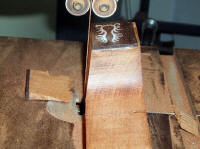
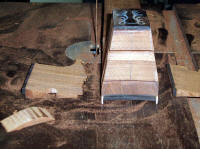
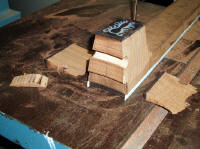
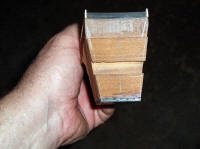
Once the vise arrives, I will file the binding and frets before
proceeding any further.
I got the little ShopFox Parrot vise in from Grizzly via an Amazon order
the other day and mounted it to a
portable oak base plate for C clamping to my table saw table which serves as my
work bench too....grin if you must! The Parrot vise is well worth the
money but if I were doing instrument repair and building necks on a regular
basis, I would seriously consider the guitar makers vise from Stewart
MacDonald which cost at least three (3) times as much but in this case, well
worth it! The StewMac vise has several features not available on the
Parrot vise. Also, during the course of shaping the neck with hand
tools, I modified/tweaked the neck holding fixture to allow sanding the neck
peghead too. Pixs below:
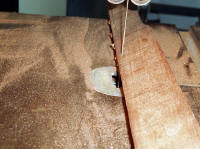
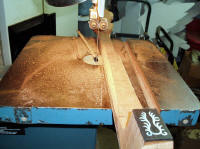
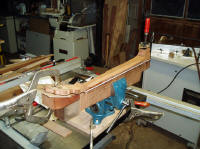
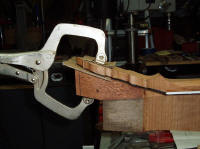
I removed material from the neck blank using the band saw and to save a
little on the hand aka elbow grease power. If I was in a musical
repair environment, I would make the peghead portion of the neck holding jig
adjustable to accommodate different peghead angles but this one fits my neck
template although not perfect since I used what scrap wood I had on hand.
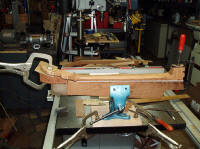
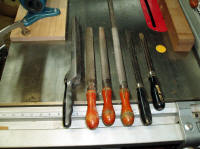
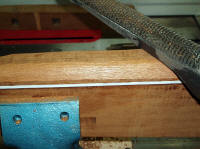
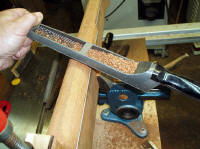
After clamping the neck down at the heel and peghead and provided some
protection using cardboard as a caul and a piece of heavy leather or thin
carpet would work
much better. The second pix of the hand tools I will be using and the
Stanley Surform tool was used to remove the bulk of the material and it cuts
very fast and aggressive. The large curved replaceable blade does a
great job shaping the sides of the heel. The second tool is a very
rough cut rasp, however I didn't use that tool but a little since it is far
too rough for this application and a regular bastard half round medium rasp
works much better. I used the Stanley round surform tool mostly around
the peghead hand volute or hand stop area and was invaluable in getting the
radius portion of the heel to blend in with the neck.
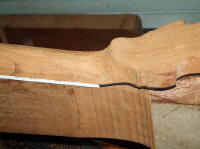
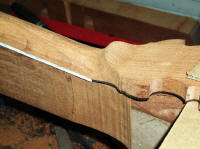
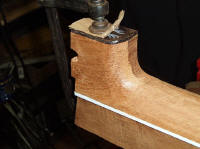
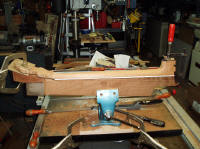
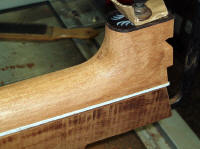

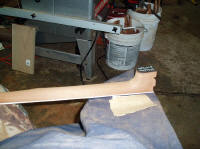
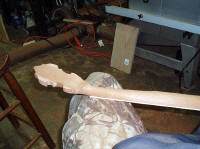
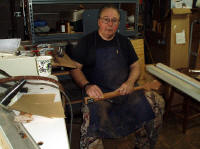
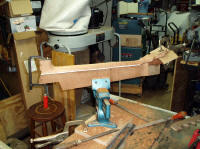
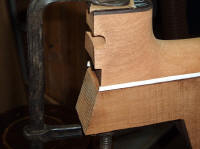
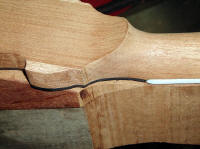


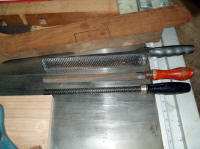
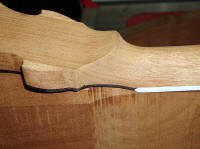
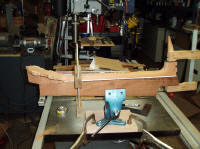
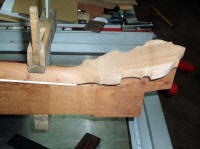
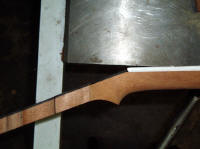
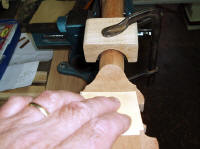
Shaping this neck brought back a lot of good memories and one that wasn't
so good as I remember one of the first necks that I made and ended up
wrapping it around the column of my drill press...it was supposed to have
been a piece of kiln dried walnut and I got down to the shaping of the neck
stage as in this neck and the neck continued to get a back bow in it and
that was in the days before the two-way adjustable truss rods. I
vented my frustrations out and literally broke the neck by slamming it hard
against the drill press column. In the future, I took better care in wood
selection paying attention to moisture content, etc....grin if you must!
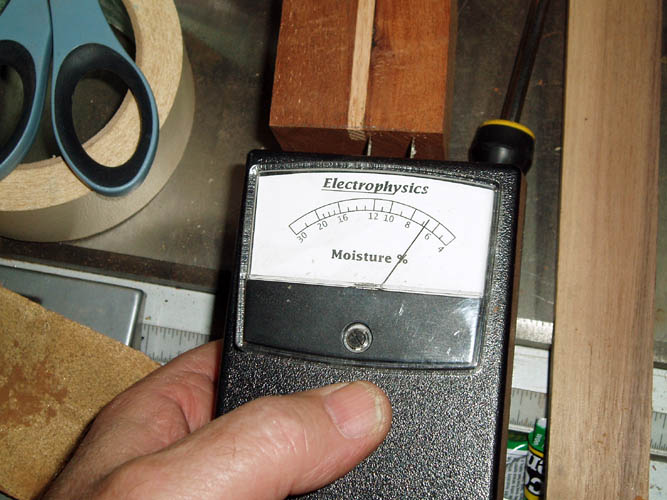
Checking moisture content with a calibrated meter is not a bad idea for
musical instrument woods. Meters are like anything else, most of the
time you get what you pay for, but you don't have to break the bank
purchasing one and understand a few simple conversions you have to make for
different species of woods. I have purchased turkey box call wood that
came in reading 16 to 18 percent moisture and some woods higher of which the
seller was truly a "flim flam" artist on EBay!
The above sequence pixs is nothing high tech at all and in fact about as
low tech as you can go unless you get out the ole pocket knife and starting
whittling instead of using the surform tools and rasps. I have
completed necks before without a good neck holding jig or fixture but it
certainly does make it much easier, however once I get to the sanding stage,
I will sit down and take a load off my feet whenever I get the chance.
I would use a rocking chair in a heart beat for the sanding stage, however
sanding the back of the peghead and keeping it flat works better for me
using the neck holding fixture. The above fixture is multi-purpose and
works well for shaping and sanding the neck; just change the style and
position of the clamping devices.
I modified the fixture for better usage with the Parrot vise by routing a
3/16 inch deep mortise into the wood fixture to fit the jaws of the vise
which keeps the fixture located in the same position when you release
pressure on the jaws allowing the vise to be rotated up to 360 degrees.
I would rather have a feature that allows the vise jaws to remain closed and
rotate the base but that is my personal preference. I reduced the
width of the fixture underneath the peghead to allow sanding around the
double cut peghead. I got some hand sanding on the neck with fairly
rough sanding paper, 100 grit to remove any tool marks from the rasps and
surform tools and will drill the holes in the peghead for the tuners and
also the 5th string peg before progressing to fine grades of sand paper.
I found an old leather belt and made a wooden set of cauls for the Parrot
vise and when dry, will sand an angle on the back of the wooden blocks
(cauls) to allow for holding a tapered item such as a guitar or banjo neck,
etc., Pixs below:
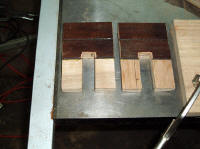
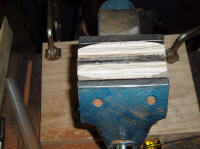
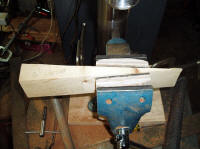
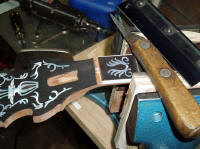
The cauls with the curvature against the vise jaws works great and should
handle most instrument tapered necks and parallel items as well. I cut
the excess binding off at the nut end of the fingerboard using a small fret
saw and thin bladed utility knife that has seen a lot of usage in the past.
PREVIOUS PAGE
NEXT PAGE
BANJO CONSTRUCTION HOME PAGE
LEAVING ON A
SPIRITUAL NOTE
If you do not know Jesus Christ as your Lord and Savior, please take this
moment to accept him by Faith into your Life, whereby Salvation will be
attained.
Ephesians 2:8 - 2:9 8 For by grace are ye saved through faith;
and that not of yourselves: [it is] the gift of God: 9 Not of works, lest
any man should boast.
Hebrews 11:1 “Now faith is the substance of things hoped for, the
evidence of things not seen.”
Romans 10:17 “So then faith cometh by hearing, and hearing by the
word of God.”
Open this
link about faith in the King James Bible.
Romans 10:9 “That if thou shalt confess with thy mouth the Lord
Jesus, and shalt believe in thine heart that God hath raised him from the
dead, thou shalt be saved.”
Open this
link of Bible Verses About Salvation, King
James Version Bible (KJV).
Hebrews 4:12 “For the word of God is quick, and powerful, and
sharper than any two edged sword, piercing even to the dividing asunder of
soul and spirit, and of the joints and marrow, and is a discerner of the
thoughts and intents of the heart.”
Romans 6:23 “For the wages of sin is death; but the gift of God is
eternal life through Jesus Christ our Lord.”
Romans 3:23 “For all have sinned, and come short of the glory of
God;”
Micah 6:8 “He hath shewed thee, O man, what is good; and what doth
the LORD require of thee, but to do justly, and to love mercy, and to walk
humbly with thy God?”
Philippians 4:13 "I can do all things through Christ which
strengtheneth me."
